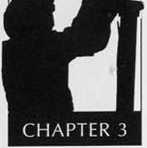

Over the four decades that Deep-Sky Wonders appeared in Sky & Telescope, Scotty watched visual astronomy evolve from its tentative and reserved roots to a burgeoning sport whose amateurs continually extend the possibilities of night vision. Advances in telescope technology and observing techniques certainly helped to revolutionize visual astronomy. Scotty often reflected on such changes, saying once that "several of winter's showpieces were considered 'test objects' not so long ago. But experience has shown that yesterday's challenges have become the stock-in-trade of today's public star parties." Through his column, Scotty almost singlehandedly advanced the rate of this progess by continually challenging observers. If one test object fell to the power of vision, Scotty would introduce another.
On one memorable trip to northern Mexico I was camped at about 6,500 feet
— a rather low elevation for this region — when a front passed around midnight and brought a view of diamond-like stars. Instead of setting up a telescope, I began to explore the sky with nothing more than a set of Lumicon nebula filters and my naked eye.
The first target was an old favorite of mine, the Rosette Nebula (NGC 2237-39) to the east of Orion in the stellar wilderness we call Monoccros. Without a filter only a tiny glimmer of light was visible, but with an ultrahigh-contrast (UHC) filter the nebula burst forth in spectacular fashion. I know of no other object in the sky where flicking a filter back and forth in front of a naked eye produces such a wonderful effect.
The Rosette (Figure 3.1) is one of the few deep-sky objects better seen with a telescope’s finder than with the main instrument. With large binoculars and good observing conditions, the Rosette may appear as a formless aura of soft light encircling a cluster. Most telescopes reveal only a neat but unassuming open star cluster. William Herschel, for example, discovered the cluster, called NGC 2244, t’ui missed the nebulosity around it during his great visual surveys in the 18th and 19th centuries. The nebulosity was discovered piecemeal by several observers. Albert Marth was the first person to report nebulosity associated with the stars.
Figure 3.1
NCC 2237-39, the Rosette Nebula in Monoceros, surrounds the open star cluster NGC 2244 like a wreath.
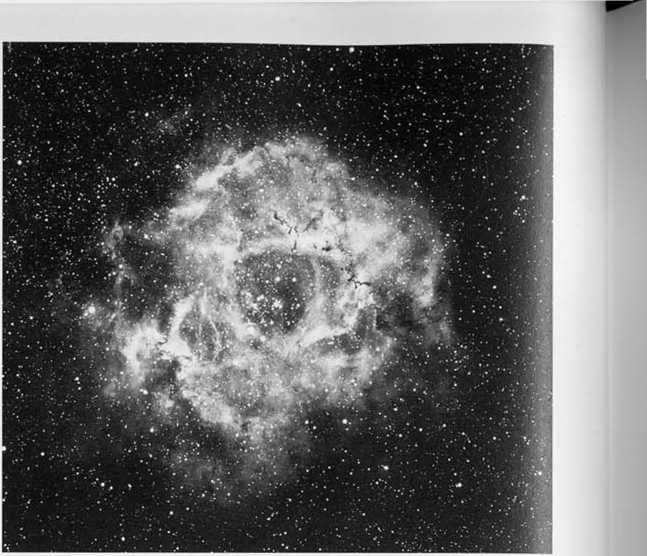
In the early 1860s he used the 48-inch speculum-metal reflector that William Lassell installed on the Mediterranean island of Malta and found NGC 2238. a “small star in nebulosity.” Herschel’s son John found one section, and the skilled American comet hunter Lewis Swift added two more in the 1880s (one of them he even suspected of being the same object observed by Marth). Collectively these nebulosities form the Rosette Nebula, an object with far better name recognition among today’s amateurs than NGC 2244, the cluster it surrounds, even though the latter was the only object mentioned in observing guides until recently.
NGC 2244 was itself once a test for the naked eye. The brightest star here is 6th-magnitude 12 Monocerotis, but it’s quite likely in the foreground and not an actual member of the cluster. Sky Catalogue 2000.0 lists NGC 2244 as having about a hundred stars and a total brightness equal to that of a 4.8-magni-tude star. Despite these impressive credentials, the cluster was missed by Messier and his fellow comet hunters in the 1700s. William H. Smyth, who observed with a 5.9-inch refractor, rightly called it “a brilliant gathering,” but he also failed to detect the faint Rosette Nebula. As I mentioned, it wasn't until William Herschel began his comprehensive sky survey toward the end of that century that the cluster was discovered. With an estimated age of 3 million years, NGC 2244 is very young; in fact, the Rosette Nebula is the cloud of gas and dust that gave the cluster its birth.
I learned of the Rosette while in grade school. During the 1940s when I began riting this column, I mentioned only the star cluster, thinking that the nebulosi-could not be seen in amateur telescopes. After all, the great 19th-century English observers W. H. Smyth and T. W. Webb never mentioned the nebula in heir classic observing guides. In the 1970s I persuaded Canadian amateurs Fred tossing and Rolf Meier in Ottawa to look for it. Even using a 16-inch reflector, they could barely see the brighter parts.
It amazes me how quickly a hitherto ignored nebula took on the mantle of a test ibject Mostly through word of mouth, observers were encouraged to search for the Rosette. Everyone looked but most failed to sec it. By the mid-1970s letters were filling my mailbox asking for help with seeing the elusive wreathlike clouds of gas around NGC 2244. So I asked readers of this column if they would look for the Rosette, and I did the usual experimentation with the telescopes I had at hand. My 4-inch Clark refractor showed nothing, while perhaps a trace was seen with my low-power 5-inch Apogee telescope. Believable wisps of the Rosette were visible in a pair of 5-inch Japanese naval binoculars. But what really surprised me was that sections could be seen with a 4-inch off-axis reflector made by Margaret Snow. I suspect that the high-contrast images provided by the off-axis design were a big factor in improving the nebula's visibility. Any telescope that scatters light from the cluster’s relatively bright stars will have a difficult time with the nebula.
As the 1970s drew to a close, the Rosette had established itself with observers.
Those working with 12-inch and larger telescopes had little trouble seeing parts of the nebula. With smaller telescopes there were varying degrees of success, probably much of which depended on sky conditions. Then came the nebula-filter revolution of the 1980s. Intrigued by a report by John F. Bartels of Travis Air Force Base in California, that with such a filter he could see the Rosette Nebula in Monoceros, I borrowed a Lumicon UHC filter, which is designed primarily to pass the green emission lines of doubly ionized oxygen near 5000 A wavelength. This is the nebula light to which the eye is most sensitive. In the early morning Connecticut sky I too was able to glimpse the Rosette. I found that the filter must be kept square to the eye; if it is tilted, the transmission characteristics change. However, this effect can be used to advantage. Rocking the filter slightly causes the nebula to flicker, which sometimes helps in seeing the object.
Equipped with a proper filter, just about any telescope will show the Rosette. Even my replica of Galileo’s refractor showed the faint haze. Indeed, about 1983 both Brian Skiff at Flagstaff, Arizona, and I independently viewed the Rosette with the naked eye and a nebula filter. By the way, a 10-inch telescope equipped W|th a UHC filter will show a lane of black droplets that crosses the nebula’s northwest corner. As would be expected, the field stars around the nebula appear about half a magnitude fainter with the filter than without it.
During the last two decades amateurs have demolished other traditional “test” °bjects like the Horsehead and turned them over to the rosters at star parties. Of course, the list of test objects has been updated with new, more difficult targets. at °ne time the Horsehead was a prize worth claiming.
As with most new optical devices, UHC filters take time to get used to, but naked-eye exploration of the sky through them should be interesting. The eye is a very sensitive instrument, and such things as the zodiacal band and gegenschein are more easily seen than photographed. Thus, my guess is that the Milky Way will yield new vistas and unexpected delights when carefully surveyed with the naked eye and a suitable filter.
In his March 1964 column, Scotty reveals that he first learned the constellations from Garrett P. Serviss's old book, Astronomy with an Opera-Glass. "I did not have an opera glass," Scotty wrote, "but made a 1-inch telescope from my mother's reading glasses and a hand magnifier, in a tube of rolled and glued newspapers. Through this juvenile instrument I first saw M35, and still remember the impressive sight." Serviss's work is indeed old. The copy I own is a 1923 edition of the 1888 original. Unlike Scotty, I did not learn the constellations with it, yet the book holds a prominent position on my bookshelves. To read it — like reading Deep-Sky Wonders — is to experience the romance of astronomy. Take Serviss's description of M35. To the naked eye, he wrote, "It is a nebulous speck." He went on to say that with optical aid, "No one can gaze upon this marvelous phenomenon, even with the comparatively low powers of an opera-glass, and reflect that all these swarming dots of light are really suns, without a stunning sense of the immensity of the material universe." After reading Serviss's prose, it's easy to see where Scotty found much of his inspiration.
M35 is my personal favorite open cluster (Figure 3.2). Located about 2’/?° northwest of Eta (r|) Geminorum, it is an impressive frame of bright stars with a softly flaming background of fainter ones, seemingly containing hundreds of members. William Herschel did not include the cluster in his general catalog of deep-sky objects. It was his way of honoring Messier as the man who, through his earlier catalog of about a hundred deep-sky objects, had inspired him to conduct his own sky survey. Messier, however, was not the first to call attention to M35. That honor appears to go to the Swiss astronomer Philippe de Cheseaux. who in 1746 called it “a star cluster above the northern feet of Gemini.”
Amateurs often test themselves by trying to view the cluster with the naked eye. This puts it in the same class as the galaxy M33 and the zodiacal light. Brian Skiff in Arizona, counting 434 stars ranging from magnitude 8.2 to 15.3, has concluded that M35’s total magnitude is 5.1. Thus, Skiff’s estimate puts the cluster within the grasp of the naked eye, but the bright background of the Milky Way may be a handicap. Nevertheless, one clear morning in September 1984, while waiting for Comet Austin to rise, Sky & Telescope associate editor Dennis di Cicco chanced upon the cluster with his naked eye. Have others seen M35 without optical aid? I’ve glimpsed it that way with the help of a nebula filter from my home in Connecticut. Can anyone distinguish individual stars in the cluster without optical aid?
More than just being a feat worth bragging about, the naked-eye visibility of M35 is an excellent measure of the atmosphere’s transparency. Readers have sent me many observations in which they note the transparency on a scale of 1 to 10. gut invariably this turns out to be little more than a wild guess. While not perfect, it would be more meaningful to note whether M35 was seen with the naked eye.
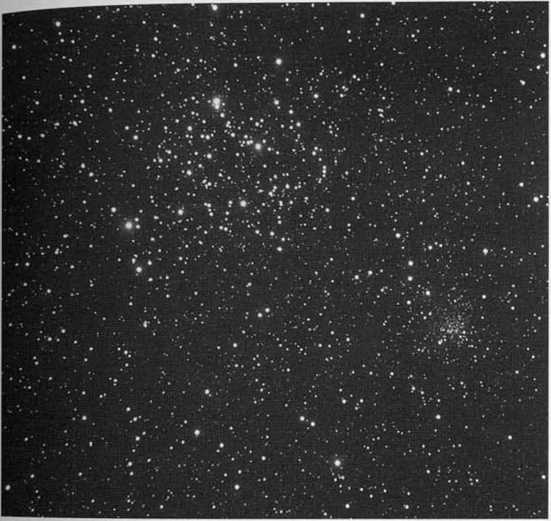
Figure 3.2
To the naked eye, Scotty's favorite open cluster, M35, appears as a fuzzy knot in the Milky Way. It is flanked to the southwest by "tiny" NGC 2158, a rich galactic cluster about 16,000 light-years away. M3 5 itself is about 2,800 light-years away.
The standard measure of the night’s transparency is the faintest star visible to the naked eye. But there is some question as to whether looking at a point source of light is a good test of sky conditions. For example, one night I watched as changing sky conditions transformed the telescopic appearance of Halley’s Comet from an 8th-magnitude, starlike point with no trace of a coma or tail to a proper 6th-magnitude comet with a distinct tail. All the while my naked-eye judgment of the sky transparency had not changed. Really serious observers can make their own lists of naked-eye nebulae and clusters and arrange them in a series of steps to determine sky clarity.
In finders M35 resembles G. P. Serviss’s description in Astronomy With an Opera-Glass: “a piece of frosted silver over which a twinkling light is playing. Small binoculars usually resolve a few stars in M35 but, for the most part, the whole group will show as a soft glow. In today’s large-aperture binoculars this cluster is a delight. Every increase in optical power produces more detail. A telescope, whether a 4-, 6-, or 10-inch, will bring out the glorious profusion of stars. At magnifications between 40x and 60x, curved lines of them appear like exploding fireworks. Indeed. Smyth likened the view of M35 to the “bursting of a sky-rocket.” Using a 4-inch refractor in Kansas, I obtained my best views with a Huygenian eyepiece of 4-inch focal length that had a field lens 4” in diameter. This ocular, a modification of the usual design, was made by Arthur Leonard of Davis, California.
I feel that M35 is one of the greatest objects in the heavens. Observers with small telescopes will find it a superb object. The cluster appears as big as the Moon and fills the eyepiece with a glitter of bright stars from center to edge. In their very useful French-language observing manual. Revue des constellations. Robert Sagot and Jean Texercau comment that M35 is a splendid cluster, easy in even the smallest instruments. They note that a few of its stars can be seen in 6 x 20 binoculars, nearly 40 in a 2-inch refractor at 20x, and about 300 in a 12'/2-inch reflector at 80x.
In the summer of 1988,1 happened to read what W. H. Smyth wrote about M35 in his 1844 Bedford Catalogue. While I had done this many times before, something new caught my eye. Smyth noted that the “center of the mass [was] less rich than the rest." This reminded me of the open cluster NGC 6811 in Cygnus, for it also has a dark center as seen with certain instruments. So that same summer I got up before dawn to look again at M35. With my 5-inch Apogee telescope at only 20x, M35 did appear like a starry smoke ring.This effect was far less apparent with the 4-inch Clark refractor at 60x, but was well seen with 15 x 65 binoculars. It was like a fat Life Saver candy, all white and glistening.
So M35 has no central condensation. There is as much dark sky between the stars at the center as at the edges. Large apertures can actually degrade the view by spreading the cluster out too much. In fact, M35 is one of the few clusters that loses its charm if you view it with too large a telescope. Anything bigger than a 12-inch spreads the image beyond the diameter of a single field, and the cluster seems to vanish. Several years ago I swept right over M35 with a 24-inch at 300x and did not realize it was there. But I recognized the field when I came upon NGC 2158.
To me M35 seems most lovely in a 6-inch at 40x — though I must admit that, through a 36-inch telescope and a wide-field eyepiece, this blaze of interwoven stars is an awe-inspiring sight. But I have probably viewed M35 the most with my homemade 10-inch reflector. This was my workhorse telescope years ago in Louisiana and Kansas. Wide-field eyepieces were rare during the 1940s and ’50s, so, using a pair of achromats and fooling with the spacing between them, I made a wide-field eyepiece of passable quality. It was a copy of what 19th-century photographers called a landscape lens, and it wasn’t far removed from the design now commonly called a Plossl.
With this eyepiece on the 10-inch I could get all of M35 into a single field. The view was too beautiful to describe with mere words. Bright stars were scattered with cosmic recklessness across the field, and it was difficult to establish where the cluster's edges dissolved into the stellar background. There were dozens of curving star chains. Everywhere I looked I could see between the stars into the black depths of infinity.
One thing always impresses me when I look at M35 — how young open clus-ters really are. Astronomers estimate that the solar system is about 4.6 billion ears old. Yet we measure the age of these clusters only in millions of years. According to Sky Catalogue 2000.0, M35 is but 110 million years old. I can pick up rocks in my backyard more ancient than that. Only a handful of open clusters are believed to be older than Earth, and none is twice as old.
As we have seen, M35 in Gemini was Scotty's favorite open cluster. But he also liked to tell small-telescope users about the presence of another interesting object nearby. "About 0.4° southwest of M35," Scotty once explained, "lies a lasting monument to my early, somewhat careless, years of observing." He was referring to the faint open star cluster NGC 2158. Absent on some epoch 1950.0 and earlier star charts, the cluster is frequently mistaken for a comet. On the other hand, "many amateurs have scanned this area," he said, "without noting that little wisp seemingly floating between us and the greater M35. This cluster, which is not especially inconspicuous, illustrates the precept that a truly magnificent object tends to distract attention from a lesser one nearby."
The compiler of a sky atlas must call a halt at some magnitude limit, and this cutoff may control the experiences of several generations of observers. Such was the case with the star cluster M35 and its faint neighbor, NGC 2158. Norton’s Star Atlas does not include the latter, and many amateur astronomers have grown up knowing nothing of it. The brief mention of NGC 2158 inT. W. Webb’s Celestial Objects for Common Telescopes seems to have been generally overlooked.
The dim, arrowhead-shaped cluster (Figure 3.3) lies right on the outer edge of M35 and is a pitfail awaiting careless observers. In my youth NGC 2158 escaped my attention until one exceptional night. From the 1920s on I had looked at M35 many times, mostly with 4- to 6-inch telescopes but occasionally with the Milwaukee Astronomical Society’s 13-inch reflector. Then, while observing with a 10-inch f/8.6 reflector in 1952 under the excellent skies of Manhattan, Kansas, I accidentally discovered a peculiar wedge-shaped object. For a few heartbeats I thought I had discovered a comet! Fortunately, before announcing my “comet” to the world, I checked the Skalnate Pleso Atlas Catalogue and found that it was ‘he small star cluster NGC 2158.
A few days after I found the cluster, I received a letter from William Davey, in New York State, who saw it with an 8-inch. His description agrees with mine: marvelous, glowing, and mysterious little cluster.” Other observers I have asked have been unable to find it at all — not surprising if you consider that NGC 2158 ls much smaller than M35, seemingly contains only one-fourth as many stars, and
Figure 33
The compact cluster NGC 2158 lies about 16,000 light-years away. Use at least a 4-inch telescope to spot it.
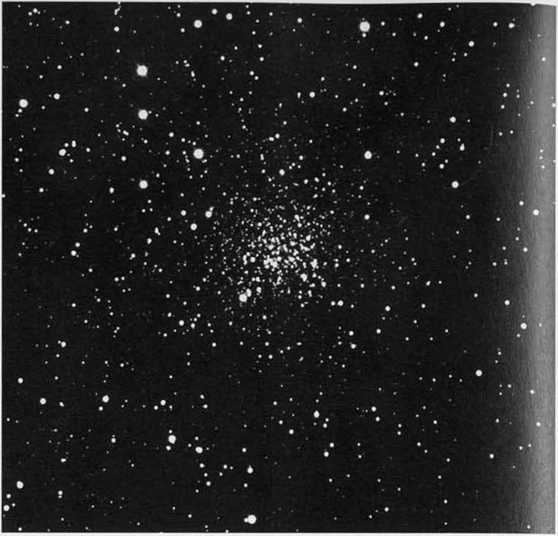

is some seven magnitudes fainter, according to the Atlas Catalogue. Why then, was NGC 2158 so conspicuous to my untrained eye in 1952, when 1 saw it easily in a 4-inch? Perhaps prolonged viewing (namely, 10 minutes) aided my perception.
The visibility of NGC 2158 is illustrated by Mark K. Stein’s experience. This veteran observer writes, “When I lived under the polluted skies of Louisville, I considered some of your descriptions of deep-sky objects the result of a fine experienced observer having a slightly overactive imagination. But now in the much darker skies of Bloomington, I can plainly see objects I wouldn’t have attempted from Louisville. From there NGC 2158 could only be glimpsed, but from Bloomington it is quite easy in my 6-inch at 95x.”
NGC 2158 is cataloged as magnitude 12.5, but different observers seldom agree on cluster magnitudes, and I think it is brighter. It is generally too difficult for apertures of less than 5 inches, and I have received only one other report of its being seen in a 4-inch. Different sources also cite the cluster's magnitude as anywhere between 11 and 12.5. Brian Skiff at Lowell Observatory estimates the cluster’s magnitude as 8.5.1 have racked my 4-inch Clark refractor out of focus until stars appear about 4' across (the same diameter as the cluster).This renders a star of 12th magnitude invisible, while one of magnitude 8.4 remains near the limit of averted vision, and appears similar to NGC 2158 seen with the telescope in focus. Thus I believe Skiff’s estimate to be much closer to the truth than the fainter values. You can try the same experiment yourself.
In a 10-inch at 90x, NGC 2158 has a soft sheen, totally unlike the neighboring
Messier object, r dust. Leonard B. stars. Although '.„.h;iblv safe in
ind resembles a diffuse nebula or a comet. It sparkles with star-Abbey, Jr., using a 16-inch at 300x. resolves this faint cluster into the exact number of stars in NGC 2158 is not known, we are assuming it is greater than the 200 in M35. Although most reference books list NGC 2158 as an open cluster, several call it a globular. Checking into the matter further I found that the group is very unusual and considered by some astronomers to be intermediate between the two types. At any rate the stars of NGC 2158 are relatively old for an open cluster and, by one estimate have been shining for 800 million years. It is similar in this regard to NGC 188 in Cepheus and NGC 7789 in Cassiopeia. NGC 2158 is perhaps 16.000 light-years from us. which would place it near the edge of our galaxy and about six times the distance of M35. If NGC 2158 were as near as M35, it would certainly be one of the most spectacular objects in the sky.
It’s always been a mystery to me why I had not seen NGC 2158 earlier, even though I was using instruments large enough to show it. I believe the reason was simply that Norton’s Star Atlas did not plot the object, and this caused my brain to reject the eye’s message of “faint cluster here.” We should not preprogram our brains before observing, and we should always be prepared for the unexpected.
Two more clusters occupy this corner of Gemini; both are challenging for small telescopes. About a degree west of NGC 2158 is IC 2157. It contains about 20 stars scattered across an area roughly 7' in diameter. The group, which lacks any central concentration, shines with the total light of a single 8.4- magnitude star. A 4-inch telescope will easily pick the cluster out of the rich galactic background. Since its brightest stars are 11 th magnitude, the cluster appears best with magnifications of around lOOx. Kenneth Glyn Jones, in his 1991 book Messier's Nebulae and Star Clusters, mentions that since IC 2157 “contains only three 10 mag. stars in a small triangle and a few others which are fainter, it is hardly recognizable as a cluster." What do you think?
While few amateurs seem to observe IC 2157, fewer still look at IC 2156, about 7' to its north and in the same field of view. It is visible in a 6-inch, and a 10-inch will show about half a dozen stars very loosely scattered. Here is a fine example of a group that is hard to tell from a random configuration of the stellar background.
In early March, brilliant Castor and Pollux can be seen at the meridian after sunset, poised high like sentinels on the banks of the River Milky Way. Castor, the more northerly of the celestial twins, carries the proud label of Alpha (a) Geminorum, •hough it is 0.4 magnitude fainter than Beta (p) Geminorum (Pollux). This historical curiosity aside, Scotty often enjoined amateurs — especially small-telescope users to turn their telescopes to Castor, which is a famous binary-star system. In 1969, the 1.9- and 2.9-magnitude components were at their minimum separation 1-9", making the double a challenging object for small telescopes. In 1980 the components widened to 2.3". The pair is 4.0" apart in the year 2000 and continues to separate. A few decades after Scotty began writing his Deep-Sky Wonders column, this orbital motion caused confusion among amateurs who found the star difficult to resolve, especially during the 1960s. Scotty was quick to explain the beauty and wonder of the situation. He also learned a lesson during an exploration of Castor's environs that left him rather surprised.
What is the most impressive sight in the heavens?To me it is the whole sky seen with the dark-adapted naked eye on a moonless winter night, when the stars seem to sparkle just out of arm's reach against a velvet blackness. On such nights in March, the Milky Way stretches across the zenith with a soft gray, structured glow never seen on lesser nights. Just after twilight ends, the pale cone of zodiacal light may be noticed slanting upward in the west. These are nights for your telescopic old favorites: the first double star you ever identified or the grandest Messier objects. You might start in Gemini by looking at Castor. Alpha (a) Geminorum, one of the great show objects of the sky (Figure 3.4). It is also among the most famous of visual binary stars.
Figure 3.4
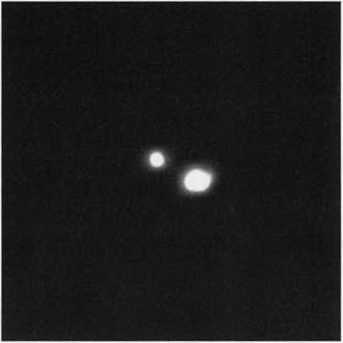
Castor, the famous binary star in Gemini, is both a visual treat and a challenge for small-telescope users. Success depends on the angular separation of its two brightest components (3.9" as seen here in 1999).
Observations of this star will be of special interest to your children and grandchildren if they develop a curiosity about the night sky, for Castor is a relatively fast-moving binary that will change visibly in coming years (Figure 3.5). John Herschel called Castor “the largest and finest of all the double stars in our hemisphere.” In 1803 his father William had announced that the two stars were orbiting each other the way planets orbit the Sun. Observing handbooks from the 19th century and even up to the 1960s often say Castor’s bright 1.9- and 2.9-mag-nitude components can be split with small telescopes. Indeed, I resolved them in the 1920s with a 1-inch homemade refractor. None of these books, however, mentioned that the stars would become a challenging pair around 1970, when the separation dropped to only 1.9".
By the mid-1960s I began receiving letters saying that Castor seemed to be a much more difficult pair than the books suggest. The observers were worried that their telescopes or eyes were failing them because they were unable to split Castor. But this is quite right. T. W. Webb's Celestial Objects for Common Telescopes mentions a measured separation of 4.4" in 1926. but by the mid-1960s the distance between the components was less than half that. It was then that I realized we were headed for a most unusual event. We would be the first generation of observers to see the famous double star at its minimum separation. Because Castor A and B have completed only a fraction of a revolution since they were first measured by the English astronomer James Bradley in 1718. their exact orbit is not well known but is believed to take about 445 years. One thing is certain, however: it will be more than four centuries before Castor’s components appear closer than they do now.
No one saw Castor as a pair of stars at its previous minimum separation, for the invention of the telescope then lay more than a century in the future. In my
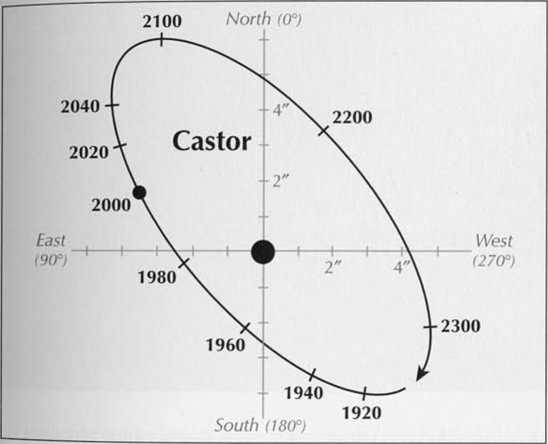
Figure 3.5
This chart shows the position angle and separation of Castor's companion from 1900 to 2300.
garden grows a white rose that came from a long line of cuttings brought to America by a sailor whose family had supported England’s Duke of York during the 15th-century Wars of the Roses. The white rose originally was the Duke’s symbol. When 1 look at the rose in my garden I think not only of the English civil wars, but also of Castor's minimum separation that passed unseen.
Even today, we witness the companion of Castor as no one will for another 400 years. According to Castor’s apparent orbit, the companion travels in a highly elliptical path around the primary. The position angle is decreasing by about 5° Per year, a change large enough to be detected with a simple homemade telescope attachment such as that described by Geoffrey Gleason on page 117 of the February 1967 Sky & Telescope. His micrometer consists essentially of a crossline attached to his telescope eyepiece, which can be turned to parallelism with the line joining the stars, and a protractor attached to the eyepiece holder. Presently the pair is widening to a maximum separation of about 7" late in the 21st century. It will then shrink to a secondary minimum of about 4" in the 23rd century. As far as I know, the secondary minimum point in a star’s apparent orbit has never been dignified with a name.
Both of Castor’s components are themselves close pairs of stars, resolved only by telltale Doppler shifts in their spectral lines. Another member of the Castor system, 9.5-magnitude Castor C, can easily be seen in a 4-inch tele
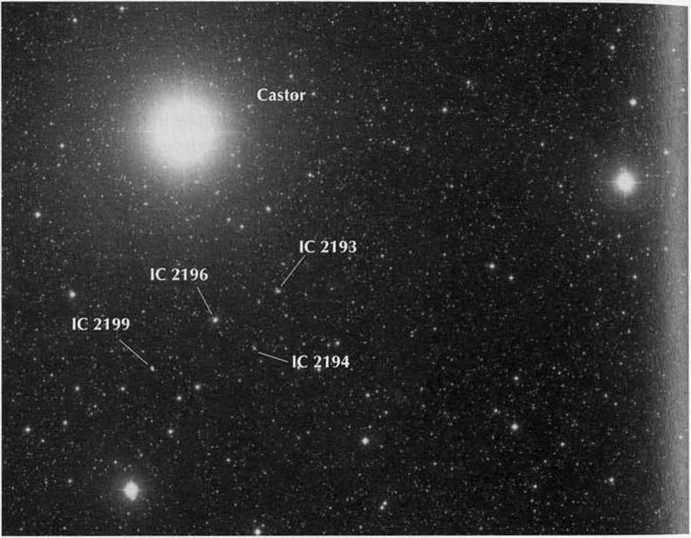
Figure 3.6
Amateurs with 8-inch or larger telescopes can spot the four faint galaxies plotted here just south-southwest of Castor.
scope. The reddish star is 73" distant at position angle 165°. Castor C (also called YY Geminorum) is an Algol-type variable star — eclipsing red dwarfs orbiting each other every 9.8 hours. So there are actually six stars in the Castor system.
After writing about Castor and making a search of the surrounding sky, I was confident that no other deep-sky surprises lurked in its glow. Thus, I was amazed by a comment I ran across in Richard H. Allen’s classic book Star Names: Their Lore and Meaning. At the end of the section on Castor it stated, “In 1888 Barnard found five new nebulae within 1° of Castor.’’Where had I erred?
in this case I made my search with atlases rather than on the sky itself.
■ -ni) worthwhile showed on Sky Atlas 2000.0, and the only thing found on the lotnetria 2000.0 charts (which have a fainter limiting magnitude for stars and deep-sky objects alike) was the galaxy NGC 2410 just 1° north of Castor. In 40 rs of writing this column I'd never before mentioned this galaxy.
Reaching for a copy of NGC 2000.0, I began a search for other objects. This is ,asV to do since the objects are ordered by right ascension in the book. I simply turned to the section that covers Castor’s right ascension and ran my finger down the list of declinations looking for ones close to that of the star. I promptly found six objects in addition to NGC 2410. All galaxies in the 14- to 15-mag-nitude range arc certainly difficult for amateur telescopes. Nevertheless, a look through a 12-inch telescope at a star party showed the six quite clearly. They make a sweet group, which I suspect will be about as difficult as Stephan’s Quintet in Pegasus. All six fit within a 'A0 field centered 'A0 south-southwest of Castor (Figure 3.6). The object nearest the center of the group is IC 2196. Has anyone seen them?
In January 1960, Scotty thanked the many amateurs who continued to write to him about their observations. "The mail is too heavy to acknowledge each report individually," he said, "but they are al! recorded and help shape the content and tone of this column. Without them, Deep-Sky Wonders would be handicapped." Scotty was comforted by the overwhelming response to his columns. Mail was a sign of appreciation. It assured him that his words were being read and that his audience was a willing one. The correspondence not only helped him generate new ideas about what to observe, it also helped him keep his finger on the pulse of visual astronomy, to follow what was being observed and what was being neglected.
In the early winter evening the atmosphere is turbulent with the day’s accumulated solar energy radiating back into space. Stars twinkle vividly. It is at these times that I like to turn my telescope on brilliant Sirius — the blazing blue-white star that has been called the “leader of the host of heaven” — and watch it dance in a rainbow of colors (Figure 3.7).
Most amateurs know the story of how Alvan G. Clark, the Cambridge, Massachusetts, telescope maker, discovered Sirius’s companion in January 1862 while he was testing an 18'A-inch objective that his firm had just made (now at Dearborn Observatory in Illinois). The star, however, can be seen with much smaller telescopes.The companion, an 8th-magnitude white dwarf, takes 50 years to orbit the primary. I first split the pair in 1932 with the same 6-inch Clark relractor used earlier by the famous double star observer Sherburne W. ®Urnham.The pair reached a minimum separation of 2.7" in April 1994. But this orbital highlight was one best appreciated in the mind's eye. The previous periastron7 occurred in March 1944.
Normally, such separations are well within the reach of amateur telescopes. However, this is no ordinary double star. With a magnitude of -1.46, Sirius is some 6,000 times brighter than the 8th-magnitude white dwarf. When the stars are closer than about 5", glare from Sirius makes the pair very difficult in even the largest telescopes. Indeed, even at their widest separation of more than 11" the pair can be extremely difficult to observe. It will be well into the 21st century before the pair again comes within reach of amateur telescopes.
One of the reasons Sirius appears so bright is that it is one of the Sun's closest neighbors. Almost every amateur knows that the nearest fixed star is Alpha (a) Centauri (actually a triple star system). However, with a declination of more than 60° south, few Europeans or North Americans ever get to view it. For us, the closest visible star is Sirius. At a distance of 8.6 light-years, it is almost exactly twice as far away as Alpha Centauri.
Figure 3.7
Canis Major is home to many naked-eye and telescopic splendors, including Sirius — the brightest star in the night sky — and 4° directly south of it, M41, a naked-eye cluster of 100 stars scattered across a Moon's diameter of sky.

Whether they see it as a double or not, many amateurs have turned their telescopes on brilliant Sirius on a crystal-clear cold winter evening, simply to watch the amazing procession of colors — reds, greens, violet-blues — as the mighty star twinkles in the heavy mantle of frigid air. Few, though, take the time to drop their finder 4° south of Sirius and wait for M41 to creep into the field of view. Yet this is a pleasant experience. In contrast to Sirius, the field below is dark and vacant, allowing the eye to regain some of its sensitivity. After a minute or two this mighty galactic cluster rides into view. Its stars shine with the total light of a sin-
^/.-magnitude sun, which puts the cluster well within range of the naked eye. ould probably be better known as a naked-eye target were it not so low in the 1 as seen front northern temperate latitudes. Its diameter is listed as 38' in Sky s italogue 2000.0. While this is more than the Moon’s width, it’s very difficult for he eye to determine where the cluster ends amid the surrounding star field.
Although the discovery of M41 is generally credited to John Flamsteed in February 1702, it was referred to by Aristotle in his Meteorologies (fourth cen-turv B C.) as a “star with a tail." In my early days of observing I never noticed M41 as a naked-eye object, even though it was described as such in T. W. Webb’s Celestial Objects for Common Telescopes. W. H. Smyth, in his Bedford Catalogue, talked more about a double star within M41 than about the cluster itself. I suspect he would have been more enthusiastic had M41 been better placed above the horizon at his home in England.
A note in my travel diary made at Lake Atitldn high on the Guatemala plateau states that M41 outrivals the adjacent Milky Way. And my observing notes from years ago when I lived in Kansas say that M41 is easily visible to the naked eye, being brighter than Mil in Scutum.Try to estimate the visual magnitude of this cluster by comparison with surrounding stars, with the aid of binoculars racked far out of focus.
M41 is an excellent subject for small telescopes and low powers. Here more than a hundred stars are scattered across a Moon’s diameter of sky. Because of its declination, observers in southern latitudes should see much more than an amateur in New York, for example. Indeed, they add up to a blaze that dazzled my eye when I viewed this open cluster with a 4-inch rich-field reflector from the jungles near Tikal in northern Guatemala. Many visual observers speak of seeing curved lines of stars in M41. Although they seem inconspicuous on photographs, the curves stand out strongly in my 10-inch, and the bright red star near the center of the cluster is prominent.
Glare and scattered light from M41’s numerous bright stars mask the faintest cluster members that your telescope would otherwise show if the field were less crowded. This is one reason why a compact cluster with bright stars is a poor choice for determining the absolute limiting magnitude of a visual telescope. Telescopic fields are not the only ones affected by glare. Reports of people counting more than 17 or 18 stars in the Pleiades star cluster are rare, but many observers can reach magnitude 7.5 with the naked eye. Were it not for the bright Pleiades, these observers should be able to count upward of 30 stars in the group.
Tombaugh's Clusters and a Host of Galaxies
Most readers will know of Clyde Tombaugh, who discovered Pluto in 1930. Much more obscure, however, is the fact that Tombaugh discovered two open clusters in Canis Major about 4° east of M41.1 first learned of them while read-'ng un article by Brian Skiff in the Spring 1983 issue of Deep Sky magazine.
mbaugh 1 appears as a faint circular patch about 5' across in my 4-inch Clark refractor. I saw it as an unmistakable cluster in a 10-inch reflector, which also revealed a few individual stars, but it was with a 16-inch telescope that 1 got niy first good look at the group.
Tombaugh 2 lies less than 1° southeast of Tombaugh 1, but I failed to see it with the Clark refractor. My 10-inch reflector at 150x showed a small, 3'-diante-ter blur that 1 estimated to be about magnitude 12.8. None of its stars were resolved. Skiff’s article said that not much was known about this cluster, but he believed it was probably very old and composed mainly of yellow-giant stars.
There is also a small group of galaxies located just 6 degrees south of M41 (Figure 3.8). The three brightest are NGC objects — NGC 2292,2293, and 2295 — and should all be within range of a 6-inch telescope under a good sky. They will be easier to distinguish from surrounding field stars if a magnification of lOOx or more is used.
NGC 2293 is about 11th magnitude and has a listed diameter of 3' by 4'. Nearly the same brightness and slightly more oval is NGC 2292, just to the west of NGC 2293. Smaller, fainter, and 4' west of NGC 2293 lies NGC 2295. All three galaxies will fit within the field of a high-power eyepiece.
If you’re really up for a challenge and have a large-aperture telescope, try sweeping the area around this trio. At least 16 galaxies are catalogued within a l'Ac radius centered on the group.
Figure 3.8
A small group of galaxies lies 6° south of
M41. Its three brightest members are
NGC 2292, 2293, and 2295. They should be within range of a 6-inch telescope.
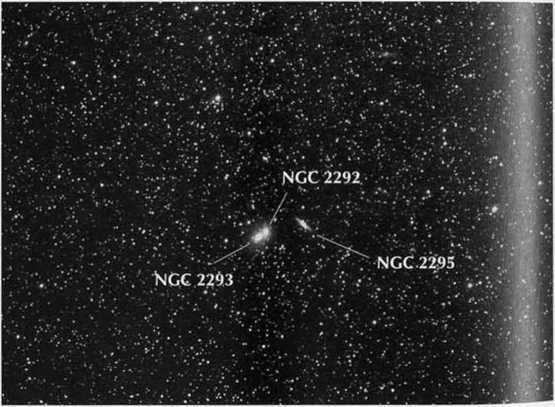
Auriga is a wellspring of galactic treasures. Specifically, the constellation contains one of the greatest collections of open star clusters known. Of course, the favorites with beginners are M36, M37, and M38, three of the brightest galactic clusters listed by Messier. "All are at the threshold of naked-eye visibility," Scotty reminded us, "and the slightest optical aid will make them stand out as striking objects." But the galactic profusion only begins with these objects. In anticipation of the full

Scotty waxed poetic, making us look forward to nightfall: "The celestial ^r<11 ire in place, a serene majesty washes over the stage, and I can almost hear 3Ct°rnuSjC of galactic trumpets in their opening bar. What better time to observe £e splendor of the heavens?"
During March evenings eight lst-magnitude stars sit in solemn conclave in the sky above my Connecticut home.Two arc in Orion, while the others are arran°ed in orderly grandeur around the great Hunter. Three naked-eye star cjusters__the Pleiades, Hyades, and Praesepe — are strung along the ecliptic
carrying with them a wealth of ancient folklore. Near the meridian beams the great Orion Nebula, also visible to the naked eye. Galactic clusters are legion in w*nter Milky Way, and overhead Capella shepherds a profusion of them in Auriga (Figure 3.9).
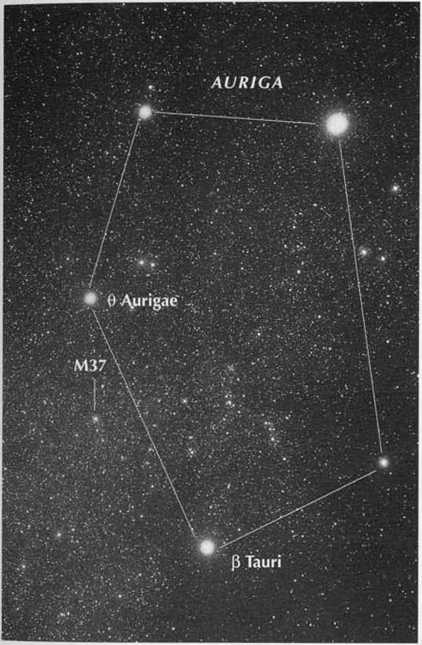
Figure 3.9
A multitude of open clusters adorns the Auriga Milky Way. The prettiest is M3 7, about midway between Theta (0) Aurigae and Beta (0) Tauri.
Th 7
e prettiest of these is M37, dimly visible to the naked eye on extremely clear f0^hlS' 3 soul’1east midpoint of a line from Beta (p) Tauri to Theta
a j . Un8ae- In binoculars or small finders M37 appears as a milky patch, while lnch shows a fine swarm of stars. In his 5.9-inch refractor, W. H. Smyth saw "the whole field being strewed as it were with sparkling gold-dust.” M37 is also the most striking of the three Messier clusters in the constellation, the brightest (visual magnitude 6.2), and has the most stars — 150, according to the Atlas Catalogue. The cluster is rather open, that is, the stars arc not impressively concentrated toward the center. Whether your telescope is a small instrument or a large reflector, M37 is a treat. The view is further enhanced by the flickering background of the Milky Way.
Nearby is M36, a rich cluster of fainter stars, somewhat smaller than M37, but also impressive. The cluster measures 12' in diameter and contains 60 stars. It js sparse compared to M37, and visually the stars tend to form a blunt cross. About 1° to the west is the faint reflection nebula NGC 1931.1 have seen this 3'-diam-eter object in a 10-inch reflector, but have never looked for it with smaller instruments. How small an instrument is needed to see this faint nebula?
Moving "down” the Milky Way we run into such variegated star fields and clusters that it is almost impossible to know where to halt, but this might very well be at M38. Although this cluster is well within the star-strewn Milky Way. it is usually visible to the naked eye without much effort. It is certainly far easier than M33 (the Triangulum Galaxy), and probably easier than Mil. the Scutum cluster. Evenly compressed into a glowing ball two-thirds the diameter of the lull Moon are over 100 softly blazing stars. M38 is magnificent in any sized instrument. Photographs usually show a departure from circularity, a feature quite evident to visual observers. Older reports almost always mention a cross shape (like M36), which seems more pronounced with small instruments. A view with a 24-inch reflector on a fine Arizona night showed the cluster as irregular, and the host of stars made fruitless any effort to find a geometrical figure. Astronomer J. Cuffey places it at 2,804 light-years.
Nearly 3° to the west is small, delta-shaped NGC 1893, estimated to be only one million years old. When this object was born, the Allegheny Mountains were already vastly eroded and early humans were chipping away at their not-so-primitive stone tools. Attesting to its youth, this cluster is still involved with the dust and gas that gave it birth, the diffuse emission nebula IC 410. The cluster measures about 10' across. Sky Catalogue 2000.0 lists it as having a total magnitude of 7.5, but I would have estimated it to be slightly fainter. It contains a conspicuous Y pattern formed by four 8th-magnitude stars. British amateur Guy Hurst comments that NGC 1893 is ‘‘very rich with a haze of unresolved stars.' But here is an interesting point. In small apertures, the cluster does show a haze of unresolved stars, but, as mentioned, NGC 1893 is involved with the nebula IC 410. Like many observers, I have looked at the cluster but not seen the nebula. Could the glow we attribute to stars just below our telescope’s limit really be due to the nebula? Has anyone examined this group with a nebula filter? The results might be startling.
Other clusters lie nearby that will reward the earnest observer. They range from those with a dozen or so stars up to grand collections that must have narrowly escaped being included in Messier’s famous catalog.
For starters, let's try hunting down NGC 1857 at the edge of the Milky Way
■ the pentagon of Auriga. William Herschel discovered it in 1785, and it is W* 33rd object in his class Vll (pretty much compressed clusters). He described taC -considerably rich." being a grouping of some 45 stars spread across about '*/*. sky. Us array attracted the notice of W. H. Smyth nearly 140 years ago ’ ° use of a double star in its midst. Agreeing with John Herschel that the clus-C s brightest member is orange-colored. Smyth also noted a faint triple star on 'he cluster's north side. A finder will show it as a hazy patch surrounding an orange 7th-magnitudc star. At 20x my 5-inch Apogee telescope reveals a brighter haze but still offers no clue that NGC 1857 is a cluster. But the view through a 4-inch off-axis reflector immediately announces that this is a faint collection of stars. Writing in the Webb Society's Deep-Sky Observer’s Handbook, Vol 3. Open and Globular Clusters, Hurst reports seeing 17 stars mostly of 10th and Hth magnitude spread across a 7' field. He observed the cluster with a 10-inch reflector at 120x.
Brian Skiff of Flagstaff, Arizona, remarks that it’s easy to unwittingly sweep over NGC 1857 with a 6-inch telescope, but adds that he has seen about 40 stars here with a 10-inch. He also notes that glare from the 7th-magnitude star hampers efforts to view the cluster. Although 7th magnitude doesn’t seem very bright, when you push a telescope to its limit even modestly bright objects in the field can present problems.
As a test, I made a small occulting mask (a paper punch was ideal for cutting a small circle out of black paper) and attached it to the field lens of an old Erfle eyepiece. Unlike many eyepiece designs, the front surface of this Erfle’s field lens is almost exactly at the focal plane of the eyepiece and the perfect “support” for the mask. Again, I took on the challenge of NGC 1857. With the 7th-magni-tude luminary hidden behind the mask, the sky appeared to darken and stars at least a half magnitude fainter were seen. I found this so surprising that I repeated the test three times. The result was always the same: a truly improved appearance of NGC 1857.
Several other Auriga clusters are seldom observed by amateurs. NGC 1664 tends to be difficult in my 4-inch Clark refractor when stars fainter than 11th magnitude cannot be seen. There seem to be 15 or 20 stars in a 15' area, but I estimated several times that number with my 10-inch reflector in Kansas. The cluster appears wedge-shaped, with a foreground star of magnitude 7.5 that is at lts eastern edge. NGC 1664 is in many ways similar to NGC 1857, albeit some-what larger. It too would benefit from an eyepiece fitted with an occulting mask tnce a 7th-magnitude star lies just on the southeast edge of the group. In a find-er’ NGC 1664 manifests itself as a faint blur with no indication that there is a cluster hiding here. The familiar outlines of an open cluster emerge into view Wlth a telescope somewhere between 4- and 6-inch aperture.
Observers working with 8-inch and larger telescopes comment enthusiastical-0,1 the richness of NGC 1664. Many mention numerous star chains. I once had an impressive view of these meandering strings of stars with a 12-inch telescope It was almost as if small, roughly circular patches of dark material blocked tlle view in places. I even nicknamed the group the 4-H cluster because it had the appearance of a four-leaf clover that most farm children recognize as the symbol of the 4-H Club. This asterism, however, seems reserved for telescopes of io. inch aperture and up; it does not show in my 4-inch Clark refractor.
NGC 1664 is estimated to have a rather middling age of 300 million years There are more than 100 stars here brighter than 17th magnitude, so the group continues to show more detail as the viewing aperture increases.
For something more challenging, try NGC 2126, some 5° north of Beta (p) Aurigae. I had thought it might be troublesome for a small glass, but one fine night I spotted it with my 4-inch refractor as a coarse grouping of 20 or 30 stars. Curiously, my 5-inch Apogee telescope stubbornly refused to reveal the object at 20x. Perhaps I was less familiar with the appearance of the field at that low power and was not looking in the right spot.
For a change of fare, try the seldom-observed NGC 2281. This handful of stars, whose total light is equivalent to magnitude 6.7, is scattered over an area 0.3° across. To the northeast of the cluster, photographs reveal a lane about 0.6° long that contains very few stars. I have tried many times to discern this lane but with inconclusive results. My most encouraging observations were with 5-inch 20x binoculars; on at least a half dozen nights, I thought I saw this dark “tail" of NGC 2281.
Amateurs using larger telescopes can test their skill on the midget open cluster NGC 1883. Even William Herschel called it “very faint." Lying 1.7° eastnortheast of brilliant Capella, NGC 1883 is only 3' in diameter and is listed at total magnitude 12.2. rhe Atlas Catalogue gives it 20 stars, but with a 16-inch in Texas I once estimated twice that number. When a spot of truly clean weather came through one fall, and my 4-inch was going easily to magnitude 13.5 on AAVSO variable-star fields, NGC 1883 was just held as an indistinct blur of starlight.
To complete our survey, look for NGC 1907. It’s an easy object that will show in large binoculars and even finders. A 6-inch telescope will deal with it nicely. The group is somewhat elongated in the direction of the galactic plane. Most of us have heard that the stars in open clusters are being pulled apart by tidal forces in the galaxy. But it’s seldom that the pundits point to specific clusters where this is evident from a brief look. In the case of NGC 1907, I’ve never been told that anything special is happening here, but it’s fun to look and use your imagination.
Scotty was an opportunist. One morning, the mercury-vapor streetlight near his observing site went out. The sky was exceptionally clear, and he took the chance to observe some deep-sky wonders in Lepus, the Celestial Hare, as well as some sights in Columba (the Dove), very low in the south. This month the Celestial Dove trail
meridian around 8:30 p.m., so it is well-placed for viewing as long as the s'15. n remains free of atmospheric haze. As we shall see, Scotty didn't just lazily 1 the horizon with his instruments — he experimented, too. He was a 5.C^n and modified his 5-inch binoculars so that the right ocular provided 20x hile the left ocular was boosted to 60x with a Barlow lens. He continues the story below.
Although binocular vision was impossible, I could readily compare the effect of changed magnification at the same aperture. Also, the 20x unit made an excellent finder for the other. The lOth-magnitude spiral galaxy NGC 1792 (Figure 3.10) on the Caelum/Columba border was easy. One way to locate NGC
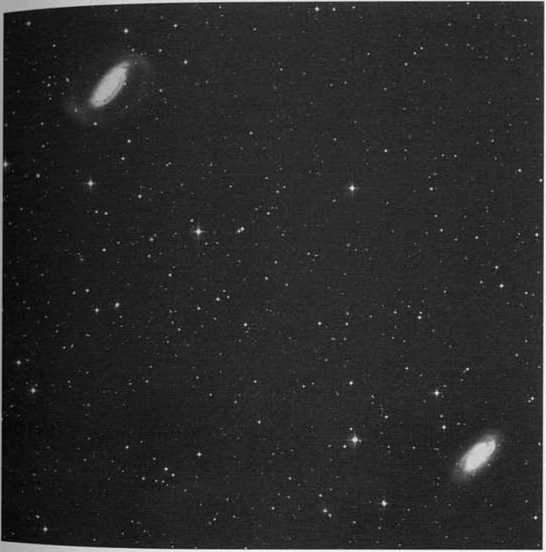
Figure 3.10 The mighty twin galaxies NGC 1792 (lower right) and NGC 1808 in Columba hug the winter horizon in north temperate latitudes.
1792 is to sweep 3° south and slightly east of 4.6-magnitude Gamma (y) Caeli. I saw the 3' by 1' object immediately at 20x. It has a neighbor, NGC 1808, two-thirds of a degree away, very similar in size and shape but a bit fainter.
The night was so transparent that I tried a really deep dip toward the southern horizon, looking for NGC 1851. a globular cluster in Columba. Actually, this 5 ball of stars is quite bright, about 7th magnitude, and must be a fine sight from •he Southern Hemisphere. It was readily seen at 20x.
Other objects might require more aperture from our northerly locales. For instance, a bit northeast of the halfway point between the 3rd-magnitude stars A1Pha (a) and Beta (p) Columbae lies NGC 2090. It was reported by John Herschel to be a bright, partly resolved globular cluster, but it has been known for many years to be actually a spiral galaxy of the 12th magnitude. It is 2.5' long and in a 7-inch refractor does indeed look rather like a globular. Try searching for it at about lOOx. In 1974 I found it from Connecticut with the 4-inch Clark at 74x, but it was not visible in the brighter field of the Apogee telescope, which also means it might have been too difficult for my binocular experiment as well
Figure 3.11 A distant 54,000 light-years away from our Sun, globular cluster M79 in Lepus can be seen under dark-sky conditions with a pair of binoculars.
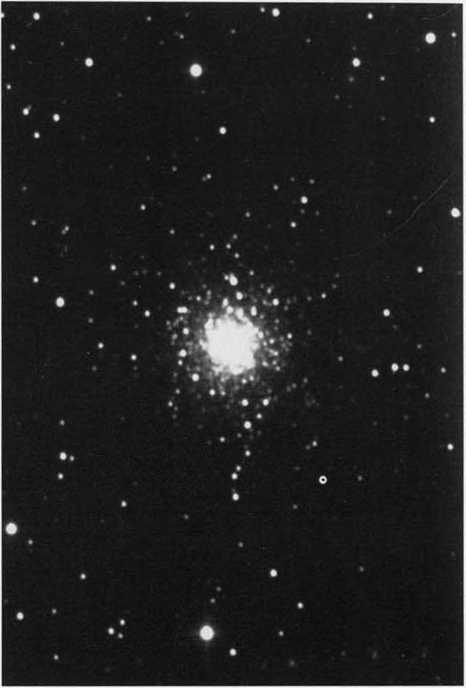
Bordering Columba to the north is the famous celestial Hare, Lepus. For such a prominent constellation, it is one of the least visited by amateurs. Its principal highlight, of course, is the fine globular cluster NGC 1904, better known as M79 (Figure 3.11). It was actually first seen by Messier’s colleague Pierre Mechain. This compact stellar swarm has a total brightness matching an 8th-magnitude star. Tire New General Catalogue called it a globular by oversight, copying a poor observation by John Herschel, while missing his later, correct description as “bright, irregular, gradually much brighter toward the middle.”
Today the cluster is often overlooked. Some amateurs tell me they have trouble finding it, which is surprising because M79 is 3' in diameter and can be seen th binoculars under good conditions. A little more than a !4° to its southwest -in interesting double star. h3752, discovered by John Herschel. Its 5.5- and 6.7-* nitude components are separated by 3.1". making it a fine object for 3-inch telescopes and larger.
Easier still to find is IC 418, a planetary in Lepus. Because of its 9th-magni-tude central star, this object is readily located in 7 x 50 binoculars. The sur-oundin a nebulous ring is about 14" across and a bit brighter than 12th magnitude I firs1 saw *l *n with a 10-inch reflector from the bayous of Louisiana, and my most recent view was with a 4-inch rich-field reflector from the top of a Mavan pyramid in Guatemala, where IC 418 was high in the sky.
What is the southernmost faint deep-sky object you have ever observed from the United States? An observer in the Northern Hemisphere can, in principle, see into southern declinations as far as the corresponding co-latitude. That is, from 40° north latitude one should see to 50° south declination. Horizon haze, obstructions, and pure indifference usually keep the observer from reaching far south, but it is worth the effort.
MARCH OBJECTS
|
Name |
Type |
Const. |
R. A. h m |
Dec. o / |
Millennium Star Allas |
Uranometria 2000.0 |
Sky Allas 2000.0 |
|
Castor, Alpha (a) Geminorum |
♦ ♦ |
Gem |
07 34.6 |
+31 53 |
130 |
100,101 |
5,6 |
|
h3752 |
♦ ♦ |
Lep |
05 21.8 |
-24 46 |
— |
— |
' ■ |
|
IC410 |
OC+BN |
Aur |
05 22.6 |
+33 31 |
114,136 |
97 |
5 |
|
IC418 |
PN |
Lep |
05 27.5 |
-12 42 |
302 |
270 |
11 |
|
IC 2156 |
OC |
Gem |
06 04.8 |
+24 09 |
— |
— | |
|
IC2I57 |
OC |
Gem |
06 05.0 |
+24 00 |
156 |
136,137 |
5 |
|
IC2196 |
Gx |
Gem |
07 34.1 |
+31 24 |
— |
— | |
|
M35, NGC 2168 |
OC |
Gem |
06 08.9 |
+24 20 |
156 |
136,137 |
5 |
|
M36, NGC 1960 |
OC |
Aur |
05 36.1 |
+34 08 |
113 |
97,98 |
5 |
|
M37, NGC 2099 |
OC |
Aur |
05 52.4 |
+32 33 |
112,134 |
98 |
5 |
|
M38, NGC 1912 |
OC |
Aur |
05 28.7 |
+35 50 |
113,114 |
97 |
5 |
|
M41, NGC 2287 |
OC |
CMa |
06 46.0 |
-20 44 |
322, 346 |
318 |
19 |
|
M79, NGC 1904 |
GC |
Lep |
05 24.5 |
-24 33 |
350 |
315 |
19 |
|
NGC1664 |
OC |
Aur |
04 51.1 |
+43 42 |
94 |
65 |
5 |
|
NGC 1792 |
Gx |
Col |
05 05.2 |
-37 59 |
396, 397 |
358, 392 |
19 |
|
NGC 1808 |
Gx |
Col |
05 07.7 |
-37 31 |
396, 397 |
358 |
19 |
|
NGC1851 |
GC |
Col |
05 14.1 |
-40 03 |
417 |
392, 393 |
19 |
|
NGC1857 |
OC |
Aur |
05 20.2 |
+39 21 |
93,114 |
66, 97 |
5 |
|
NGC 1883 |
OC |
Aur |
05 25.9 |
+43 33 |
— |
— |
— |
|
NGC1893 |
OC |
Aur |
05 22.7 |
+33 24 |
114,136 |
97 |
5 |
|
NGC 1907 |
OC |
Aur |
05 28.0 |
+35 19 |
113,114 |
97 |
5 |
|
NGC1931 |
OC+BN |
Aur |
05 31.4 |
+34 15 |
113 |
97 |
5 |
|
NGC 2090 |
Gx |
Col |
05 47.0 |
-34 14 |
394, 395 |
359 |
19 |
|
NGC2126 |
OC |
Aur |
06 03.0 |
+49 54 |
71,72 |
66, 67 |
_ |
|
NGC2158 |
OC |
Gem |
06 07.5 |
+24 06 |
156 |
136,137 |
5 |
|
NGC2244 |
OC |
Mon |
06 32.4 |
+04 52 |
227 |
182,227 |
11,12 |
|
NGC2281 |
OC |
Aur |
06 49.3 |
+41 04 |
89, 90 |
67,68 |
5 |
|
NGC 2292 |
Gx |
CMa |
06 47.6 |
-26 45 |
346, 370 |
318 |
19 |
|
NGC2293 |
Gx |
CMa |
06 47.7 |
-26 45 |
346, 370 |
318 |
19 |
|
NGC2295 |
Gx |
CMa |
06 47.3 |
-26 44 |
346,370 |
318 |
T- |
|
NGC 2410 |
Gx |
Gem |
07 35.0 |
+32 50 |
108,130 |
100 |
—__ |
Ast = Asterism; BN = Bright Nebulo; CGx = Cluster of Galaxies; DN = Dork Nebulo; GC = Globular Cluster; Gx = Galaxy; OC = Open Cluster; PN = Planetary Nebulo; * = Star; ♦ » = Double/Multiple Star; Var = Variable Star
MARCH OBJECTS (CONTINUED)
|
Nome |
Type |
Const. |
R. A. h m |
Dec. O f |
Millennium Star Atlos |
Uronomelrio 2000.0 |
Sky Atlas 2000.0 |
|
Rosette Nebulo, NG(2237-39 |
8N |
Mon |
06 30.3 |
+05 03 |
227 |
182, 227 |
11,12 |
|
Sirius, Alpha («) Conis Mojoris |
♦ * |
CMa |
06 45.1 |
-16 43 |
322 |
272, 273, 317,318 |
11,12,19 |
|
Tombaugh 1 |
OC |
CMa |
07 00.4 |
-20 30 |
— |
— |
— |
|
Tombaugh 2 |
OC |
CMa |
07 03.4 |
-20 51 |
— |
— |
— |
|
^1 = Asterism; BN = Bright Nebulo; CGx = Cluster of Galaxies; DN = Dark Nebulo; GC = Globular Cluster; Gx = G nc = Ooen Cluster; PN = Planetary Nebulo; ♦ = Star; » » = Double/Mulfiple Star; Vor = Vorioble Stor |
alaxy; | ||||||